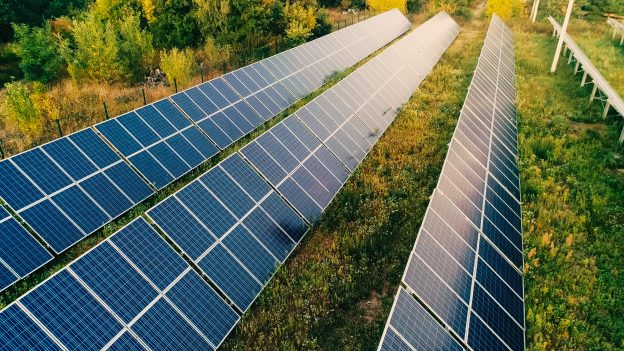1.Solar Energy: Carbon Reduction Efforts and Supply Chain Barriers as Key Differences in Energy Policies
1.1Biden Administration:
President Biden has vigorously supported the development of the solar energy industry. The Infrastructure Investment and Jobs Act (IRA) extends the Investment Tax Credit (ITC) subsidy period and promotes domestic manufacturing of solar panels. Since assuming office on January 20, 2021, President Biden has re-entered the Paris Agreement on climate change, signaling a commitment to combating climate change. Furthermore, during his tenure, Biden has implemented various supportive policies for the domestic solar industry and set ambitious carbon-neutral goals: a 50% reduction in carbon emissions by 2030 compared to 2005 levels, achieving carbon-free electricity in the U.S. power sector by 2035, and reaching carbon neutrality by 2050.
In August 2022, President Biden signed the American Inflation Reduction Act (IRA), a significant supportive policy for the renewable energy sector, particularly in the solar industry. Key supportive policies in the solar field include extending the ITC exemption period, increasing the base exemption rate from 26% to 30% (with non-residential projects needing to meet labor conditions), and providing subsidies for American-made silicon materials, wafers, cells, modules, backsheets, inverters, and tracking brackets.
Moreover, Biden administration policies such as the United Front to Limit Pollution and Anti-Evasion Investigations targeting Southeast Asia have imposed certain restrictions on domestic component companies exporting to the United States. This indicates Biden's efforts to not only promote solar installation but also strengthen domestic solar manufacturing capabilities.
1.2Trump Administration:
President Trump focused on achieving energy independence, albeit with a relaxed approach towards carbon reduction during his tenure. However, the actual impact on the U.S. solar industry remained limited.
The core of Trump's energy policy was to "make America achieve energy independence," aiming to transform the U.S. into a net energy exporter and create millions of jobs. This was pursued by leveraging domestic energy resources, primarily through relaxed environmental regulations related to oil and natural gas extraction and transportation.
Internationally, Trump's decision to withdraw from the Paris Agreement at the beginning of his term undermined global climate cooperation, significantly affecting carbon emissions reduction efforts worldwide. Domestically, the Trump administration's Energy Independence Executive Order revoked several climate-related policies, notably the Clean Power Plan, and favored fossil fuels, which restrained the development of clean energy. For instance, the administration supported projects like the Keystone XL and Dakota Access pipelines and rolled back regulations limiting coal production. These measures, while boosting traditional energy sectors, had a limited impact on U.S. carbon emissions reduction.
In the solar industry, Trump's policies, such as imposing tariffs in 2018 and extending the U.S. solar ITC exemption period in late 2020, had a notable impact. However, despite policy reversals during the Trump era, voluntary emission reduction measures by companies, industries, and state governments continued to facilitate a bottom-up carbon reduction process, limiting the actual impact on the solar industry.
2. Electric Vehicles: Stagnation in Development during the Trump Era, Increased Policy Support by the Biden Administration Focused on Domestic Infrastructure
2.1 Fuel Economy Policies:
The Trump administration relaxed fuel economy requirements, while the Biden administration tightened them. During Trump's presidency, the Environmental Protection Agency (EPA) and the National Highway Traffic Safety Administration (NHTSA) proposed maintaining the Corporate Average Fuel Economy (CAFE) standards at 37 miles per gallon for 2020-2026, overturning the Obama-era regulations aiming for a 5% annual improvement, reaching 54.5 miles per gallon by 2025. Trump signed the final SAFE rule in March 2020, reducing the annual fuel economy improvement rate from 5% to 1.5%, projecting CAFE standards to be approximately 40.4 miles per gallon by 2026. Under Biden, standards were tightened again, requiring all U.S. automotive brands to achieve fuel economy standards of 49.1 miles per gallon by 2026.
2.2 Electric Vehicle Subsidies:
The Trump administration continued the Obama-era policies regarding electric vehicle (EV) subsidies, while the Biden administration revised them. Under Trump, EV subsidies remained largely unchanged, with a basic tax credit of $2,500 per vehicle, increasing up to $7,500 based on battery capacity, with a phase-out beginning after a manufacturer sells 200,000 qualifying vehicles. Biden maintained the $7,500 maximum purchase subsidy but introduced stricter qualification criteria, eliminating the 200,000 vehicle cap but imposing conditions such as assembly in North America, sourcing key minerals from Free Trade Agreement (FTA) countries, and specific proportions of battery component production or assembly in North America. The number of eligible vehicle models for subsidies decreased from 43 to 24 in 2023 and further to 19 after the Foreign Entity Ownership Control (FEOC) rule came into effect in 2024.
The 2024 U.S. election has significant implications for energy policies, particularly in renewable energy sectors. The Biden administration takes a proactive approach, especially in solar and electric vehicles, aiming to support clean energy while emphasizing domestic manufacturing. In contrast, the Trump administration's policies are less conducive to clean energy development. However, Biden's policies also raise the bar for domestic manufacturing, potentially increasing risks and challenges for businesses.
Table:The policy differences between the Trump and Biden administrations in the energy sector
 Translated from CHINA SECURITIES.
Translated from CHINA SECURITIES.







